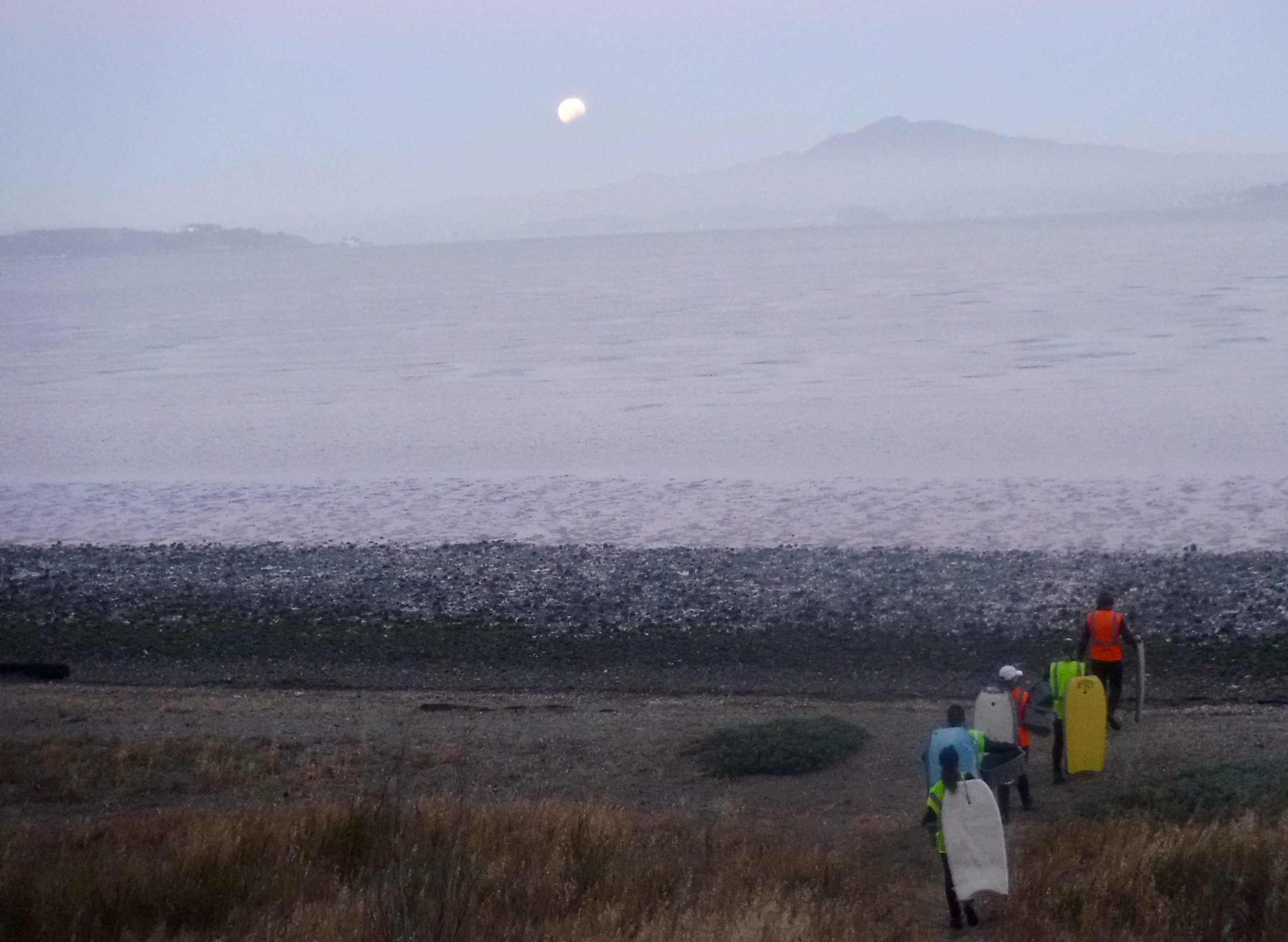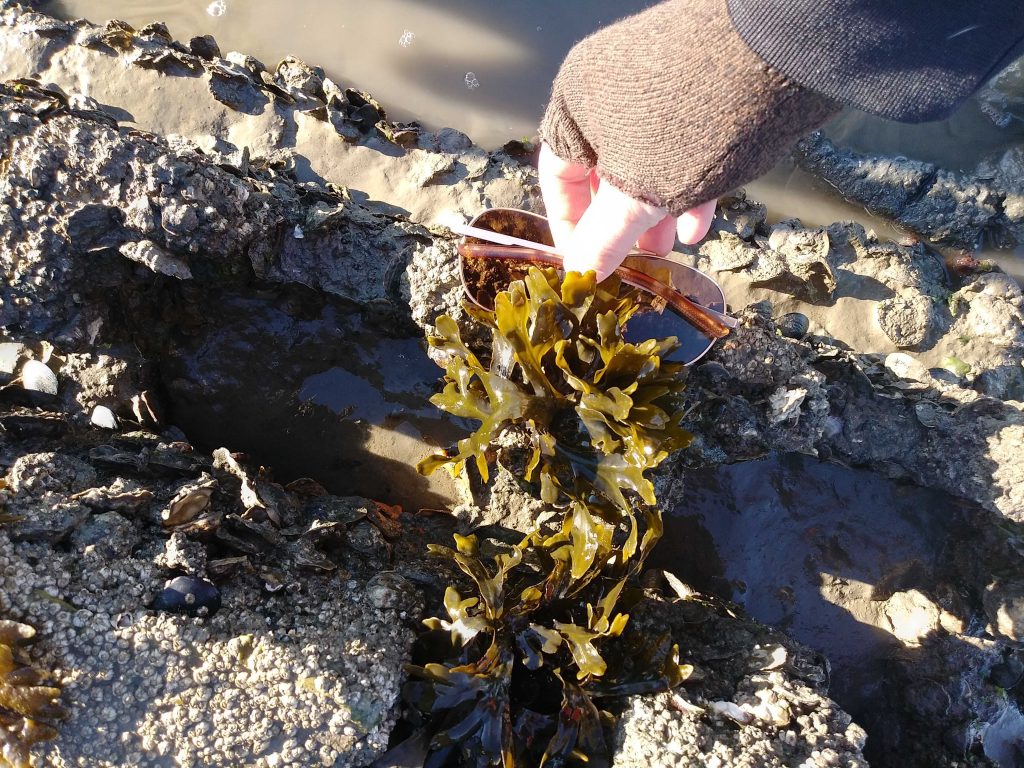
Kathy Boyer is used to getting up in the dark so she can slide across the mudflats into the Bay at first light. But this past May, she got a once-in-a-decade treat. As the professor from SF State’s Estuary & Ocean Science Center aimed her boogie board at some two-year-old eelgrass beds growing off the Richmond shoreline, the Super Flower Blood Moon rose in the blue field of the western sky.
“It’s hard to get up at 4 a.m. but if I wasn’t doing this work, I would have missed the eclipse,” said Devon Wallace, a student of Boyer’s and a recent SF State graduate, who was enjoying the chance to get in some field experience after a year grounded by coronavirus restrictions. Indeed few of members of the field crew complained of the wee-hours wake up required to participate in a low-tide eelgrass planting at Richmond’s Giant Marsh. The eelgrass is one ingredient in the region’s biggest, most complex experiment in shoreline restoration with climate change in mind to date.
The field crew collected eelgrass growing naturally near the restoration site, transplanted it back to a university lab in Tiburon, prepared it for replanting, then replanted the grass in the mud. The restoration technique, which includes attaching the eelgrass to a paper stick to prevent it from floating away from its intended location, has been used to plant eelgrass in several experimental configurations at Giant Marsh since the project was first constructed in 2019.
As the 200-acre, 22-partner project verges on its second birthday, taking stock of the results has been exciting for researchers. Led by the State Coastal Conservancy, this ambitious effort to build the entire spectrum of shoreline habitats — from subtidal eelgrass beds to oyster reefs to tidal marsh and adjacent uplands — on the East Bay shore is rapidly evolving.
Just a year after construction, more than 400,000 oysters had colonized the newly built oyster reef. This past November, another biologist, Chela Zabin with the Smithsonian Environmental Research Center, also found “gazillions of baby oysters” latched onto the undersides of small test tiles collected from the site. Another sign of success for Zabin were the rock crabs nestling in the shell bags and crawling in and out of holes in reef balls. The bags and balls are just some of the different reef-building substrates the group is experimenting with.
The crabs, the oysters, the growing eelgrass, not to mention the diving birds, are all signs that the human-engineered reef is indeed the ecosystem-builder it was all cracked up to be.
“We just had our full team meeting in April to discuss the physical and biological monitoring data through December 2020, and we’ve gained lots of excellent insights,” says project leader Marilyn Latta of the California Coastal Conservancy.
One immediate insight was that an unusual June heat wave just after the eelgrass planting in 2019 had sucker-punched one of six plots planted at different densities at different distances from the oyster reef. “To really do our experiment well, we needed to do the replant,” says Boyer, lead scientist for the project. “It wasn’t recovering, so we were basically missing one replicate of reef-eelgrass relationships.”
The heat wave and low tides that June also left another experimental planting, this time of rockweed, high, hot, and dry. Fucus distichus is a big-leafed, dark brown seaweed researchers added to the reef structure to help create shady, cooler microhabitats for oysters. “Within a day or two of placement, one batch of the Fucus just snapped off the cobbles on which they had been growing. Either they were very brittle, or it was transplant stress, or conditions just weren’t favorable,” says Zabin.
Zabin noted a die-off of mussels along the California coast around about the same time, backing up her theory about poor conditions. COVID cancelled a planned replant in 2020. Her team finally got back out on the mudflat in January 2021, transplanting in much cooler weather, and packed the Fucus more densely into the orifices of the oyster reef.
“It helped retain moisture and reduce wave stress, like having a stand of trees versus one tree,” Zabin says. (Related research by one of her interns indicates that when the tide is out, air temperature under Fucus canopy is on average 8 degrees C cooler and relative humidity is 37% higher than on a surface without Fucus.) “It creates a more hospitable microhabitat for oysters than a hot rock,” says Zabin.

Already the landscape-scale shoreline experiment — with its varieties of plots, densities, species, elevations, and restoration techniques — is suggesting one important take home: “The best elevation, in terms of oyster density, is around Mean Lower Low Water, or MLLW,” says Zabin.
Another emerging result relates to the different densities of the experimental eelgrass plantings. “Planting more densely doesn’t seem to have a facilitative effect,” says Boyer. “If you stick in more shoots you get more shoots, but dense plantings don’t amplify success.” She’s not surprised: “After doing years of restorations, I’ve found that no matter the conditions, plants pretty much decide how dense they want to be.”
Another observation is more oysters on the north side than the south side of the higher portions of the reef structure, confirming these large bivalves may be limited by heat, and reaffirming Zabin’s instinct to add Fucus to the reef. “With climate change there are more hot days and less fog, and thus an increased likelihood that a low tide will expose oysters to high temperatures and drying conditions. This research with Fucus is one of the avenues we are exploring to develop restoration methods that address climate change,” she says.
Researchers are not just experimenting in the shallows of the Bay. The multi-partner restoration team is also building arbors on the shore, using eucalyptus branches trimmed from adjacent parklands. The purpose of these branch “teepees” is to coax some native and rare marsh plants to grow higher. “The arbor technique is working really well for both the endangered California seablite and the common pickleweed; both are climbing the structures. It’s a really simple technique that anyone can do,” says Kathy Boyer. The resulting mini-mounds of succulents are intended to give marsh mice or rails refuge from high tides.
As waves, storms, and sea level advance, the experimental habitat-complex is also designed to buffer the Giant Marsh shoreline from erosion. Engineers from Environmental Science Associates (ESA) arranged different sizes of reef structures and associated seagrass plantings in a way that accounts for environmental parameters such as water depth and orientation in relation to wind and wave direction to test what works best in terms of shoreline protection.
Monitoring results show that wave energy is reduced 20 to 30% at low tides, 5 to 15% at mid tides, and minimally at high tides (see charts). “The reefs at Giant Marsh do a better job of wave attenuation the lower the water level,” says Damien Kunz, a hydrologist with ESA. Results so far are promising, he notes. “We expect the wave energy reduction will have a positive effect on sedimentation of the nearby mudflat. But I want to see the next round of data before jumping to any conclusions.”
On the shore itself, in the intertidal zone, the site is now clean enough to proceed to the next phases of the experiment — planting native cordgrass and creating tidal marsh. Over the last few seasons, the San Francisco Estuary Invasive Spartina Project has been treating the site to remove invasive cordgrass. Plans call for two native cordgrass restoration sites, one paired with the reef and one a control, to go in mud next winter. “We want to see if the reef protects the new cordgrass from high-energy waves, and preserves the marsh scarp face from erosion,” says the Conservancy’s Marilyn Latta.
In the future, the team will also be adding new sensors around the eelgrass plantings, thanks to a recent grant from the Ocean Protection Council. Eelgrass can change water chemistry (oyster shells don’t form when the water is too acid) and the sensors will help measure just how much restoration can contribute to this important function (recent UC Davis research found that some natural eelgrass beds can raise the pH of the water around them). Eelgrass can also store carbon, another research frontier of the Giant Marsh project.
While the scientists scrutinize their results, the birds are making the most of the new food factory offshore. This May, when Boyer was doing her flower moon replant, she saw an osprey catch a bat ray for breakfast. Indeed, so many herons, egrets, terns, and other birds were at the restoration site she felt like she was “in the middle of a wading, diving, feeding frenzy.”
In view of the eclipse, Boyer couldn’t help take stock of the light and dark sides of her work. “If we are going to advance this approach to adaptation, we need ten of these projects going around the Bay, and more people to do the heavy lifting,” she says.
Crawling in the mud and planting eelgrass stick-by-stick, not to mention constructing new reefs in the shallows, pushing paper, getting permits, raising money, buying sensors. and handling the dozens of other tasks associated with large-scale field experiments, is daunting. The region will need an army of the young and strong to carry on this work in the future, and to save our shores the natural way. “We have to build physical capacity to do this work everywhere around the Bay.”
The next super blood moon will appear on October 8, 2033. By then, humanity’s efforts to invest in adaptation infrastructure may begin to be eclipsed by the advance of icemelt into our Bay. We’re on the dark side, and it’s going to be bloody, but Giant Marsh is shining a light.
Prior Estuary News Stories & Video
Supershore at Giant Marsh, June 2019
Related Links
New Findings on Eelgrass Restoration at Elkhorn Slough, Ecological Applications
West Coast Eelgrass Science Synthesis
Top Photo: The May eclipse is called a Super Flower Blood Moon for these reasons: the lunar eclipse turns the moon a coppery shade of red; the event coincides with what is known as a supermoon—where a full moon is particularly close to the Earth due to its oval-shaped orbit; and finally it is called the flower moon because it occurs in the month of May, as opposed to the “harvest” moon that occurs in fall. Photo: Katharyn Boyer